As I mentioned in my previous post, there were fewer plug-n-play toys at Toy Fair this year than last. But of the ones that made an appearance, there seemed to be a more thoughtful approach as to what would make good use of plug-and-play technology. Here are a handful of new technology toys that have learning in mind and a couple of non-learning specific toys that are worth taking a look at:
ClickStart – My First Computer by LeapFrog
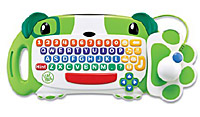 The ClickStart plug-and-play toy provides young children the experience computing in a fun and safe way, without tieing-up mom or dad’s home computer. This product includes a child-friendly keyboard and mouse, which can be set up to accommodate left or right handed users. The on-screen learning is guided by a friendly puppy named Scout. Children collect food treats for Scout as they complete games using numbers, letters, shapes and colors. This toy is a cartridge-based platform which means you can expect to see a number of different titles available to use with the base unit later this year. ClickStart is intended for children ages 3 – 6.
The ClickStart plug-and-play toy provides young children the experience computing in a fun and safe way, without tieing-up mom or dad’s home computer. This product includes a child-friendly keyboard and mouse, which can be set up to accommodate left or right handed users. The on-screen learning is guided by a friendly puppy named Scout. Children collect food treats for Scout as they complete games using numbers, letters, shapes and colors. This toy is a cartridge-based platform which means you can expect to see a number of different titles available to use with the base unit later this year. ClickStart is intended for children ages 3 – 6.
Easy Link Internet Launchpad by Fisher-Price
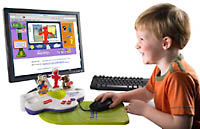 The Easy Link Internet Launchpad acts like a mom-approved dashboard to preschool-safe content on the web. Say a child would like to visit their favorite Sesame Street online game. All a child needs to do is pick up one of the many miniature figurines, in this case Elmo ( or Barney, Clifford, the Wiggles, Thomas the Train, Bob the Builder, and others) and place the figurine in its designated spot… a little like placing the round peg in the correct hole. Once inserted, the device automatically will link its user to the games section of sesamestreet.com. No typing is necessary and all content locations are child-safe with no external links to undesirable content. This product works best with children ages 3 – 6.
The Easy Link Internet Launchpad acts like a mom-approved dashboard to preschool-safe content on the web. Say a child would like to visit their favorite Sesame Street online game. All a child needs to do is pick up one of the many miniature figurines, in this case Elmo ( or Barney, Clifford, the Wiggles, Thomas the Train, Bob the Builder, and others) and place the figurine in its designated spot… a little like placing the round peg in the correct hole. Once inserted, the device automatically will link its user to the games section of sesamestreet.com. No typing is necessary and all content locations are child-safe with no external links to undesirable content. This product works best with children ages 3 – 6.
Digital Arts & Crafts Studio by Fisher-Price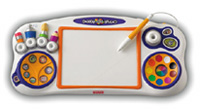
This digital art station plugs right into the USB port of your computer. The device has a drawing tablet and a stylus for kids to draw. Drawings made on the tablet will appear on the computer monitor. A number of different creative templates are available to get kids started, like custom-designed birthday cards, party materials, and other holiday and artistic treats as well. Completed artwork can be printed out on your own color printer. Parents will be happy to know the number of printed items coming from this toy can be limited so expensive color printer ink can be used sparingly if desired.
Whiz Kid Learning System by VTech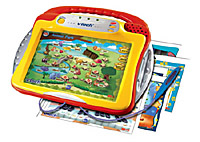
This learning platform is unique in that it can be used with or without a computer, though it is a USB plug-and-play device. It has the ability to go where the child goes, untethered to some video monitor if desired. Up to 40 different activity pages can slide into this device for use with a stylus to make interactive selections on the tablet. Each page includes three different interactive learning activities. This product is also considered a platform, which means additional titles can be purchased to extend the learning and play experience through the base unit. (Additional titles for this product are referred to as “Wizware.”) Titles provide reading-based content as well as math, phonics, logic and creativity learning activities. Children ages 3 – 6 are intended audience for thsi product.
EyeClops by Jakks Pacific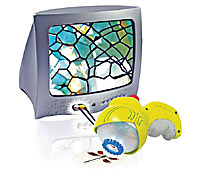
This toy is not being released as a learning product, but I think it has huge learning potential. EyeClops plugs right into your TV and acts like a 200X microscope. Wherever your child points the camera lens the result is in a giant magnified visual on your TV screen. What does the surface of your skin look like close-up? What about that bug? What exactly is in that rug of yours? Exploration and discovery is the name of the game with this toy. The target audience is described as 8 – 12, but I think this toy has the ability to expand into other ages as well.
NetJet by Hasbro
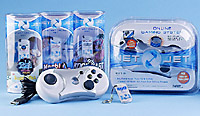 NetJet is a clever USB connected handheld device created by Tiger Electronics, a division of Hasbro. NetJet consists of a handheld game controller and a game key. Each game key inserted into the controller allows its user to access different casual game content online. Popular games using familiar characters and brands are available through this device, but not to those without the controller and keys. The NetJet environment is also free of advertising. No banner of pop-up ads here. Kids are also kicked offline once the NetJet device is removed from the USB port. By this coming fall season, 40 different casual game titles will be available for purchase. This product will appeal to casual gamers, both young and old, but Tiger is best know for their success with the tween market. This is not a learning product, but NetJet is an excellent use of plug-and-play technology.
NetJet is a clever USB connected handheld device created by Tiger Electronics, a division of Hasbro. NetJet consists of a handheld game controller and a game key. Each game key inserted into the controller allows its user to access different casual game content online. Popular games using familiar characters and brands are available through this device, but not to those without the controller and keys. The NetJet environment is also free of advertising. No banner of pop-up ads here. Kids are also kicked offline once the NetJet device is removed from the USB port. By this coming fall season, 40 different casual game titles will be available for purchase. This product will appeal to casual gamers, both young and old, but Tiger is best know for their success with the tween market. This is not a learning product, but NetJet is an excellent use of plug-and-play technology.
Digi Makeover by Radica
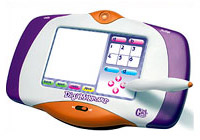 This TV plug-and-play device first appeared at last year’s Toy Fair. It has a built in camera which allows it’s user to take a picture of oneself, then, through the controls on the tablet, modify hairstyles, add jewelry, and apply makeup. (Note: This product has brought about much discussion in our office about female stereo-typing and the kinds of messages it sends out to young girls. In our own testing of the product, we find that kids enjoyed the product greatly when we referred to it as a “stuffed animal makeover” toy. Kids couldn’t stop laughing when they gave a giant stuffed Pikachu and other fuzzy friends a new hairdo and pearls!) What’s new here is Radica has hinted it will be releasing an newer version of the device later this year but no formal announcement has been made.
This TV plug-and-play device first appeared at last year’s Toy Fair. It has a built in camera which allows it’s user to take a picture of oneself, then, through the controls on the tablet, modify hairstyles, add jewelry, and apply makeup. (Note: This product has brought about much discussion in our office about female stereo-typing and the kinds of messages it sends out to young girls. In our own testing of the product, we find that kids enjoyed the product greatly when we referred to it as a “stuffed animal makeover” toy. Kids couldn’t stop laughing when they gave a giant stuffed Pikachu and other fuzzy friends a new hairdo and pearls!) What’s new here is Radica has hinted it will be releasing an newer version of the device later this year but no formal announcement has been made.
In my next blog article, I’ll take a look at more technology toys that are intended to get kids moving and active!
Average Rating: 5 out of 5 based on 275 user reviews.


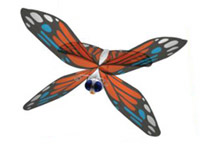 If I could take just one toy home that I saw at Toy Fair, it would be this one. (Remember, I spent three days at the show and saw LOTS of new products). In a tiny little booth, way in the back of the Javits Center, far off the beaten path, I discovered this gem. It’s a remote controlled butterfly that actually flies. While this product is not positioned as a learning product, I see all kinds of home and classroom discussions opportunities about the history of flight, butterflies, metamorphosis, technology and more. At the time of this blog post, the company’s website has not been built, but for those interested in learning more you can email inquiries to: info (at) supercreation (dot) com (dot) hk. Click
If I could take just one toy home that I saw at Toy Fair, it would be this one. (Remember, I spent three days at the show and saw LOTS of new products). In a tiny little booth, way in the back of the Javits Center, far off the beaten path, I discovered this gem. It’s a remote controlled butterfly that actually flies. While this product is not positioned as a learning product, I see all kinds of home and classroom discussions opportunities about the history of flight, butterflies, metamorphosis, technology and more. At the time of this blog post, the company’s website has not been built, but for those interested in learning more you can email inquiries to: info (at) supercreation (dot) com (dot) hk. Click 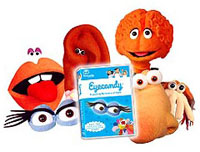 Braincandy is a young company specializing in making DVD and audio CD products for very young children. Currently they have two DVD products available that help children learn about themselves through their flagship title that focuses on the five senses; a second is all about sight.
Braincandy is a young company specializing in making DVD and audio CD products for very young children. Currently they have two DVD products available that help children learn about themselves through their flagship title that focuses on the five senses; a second is all about sight. 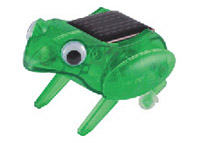 OWI is a technology toy company that specializes in offering small robotic science kits. This year they unveiled a number of new solar powered critters. To assemble, simply snap together all of the electronic parts. No soldering is required. Then you can watch them move when a light source is made available to power their motors. While you cannot currently purchase these items through the OWI website, I’ve provided links here to another distributor where you can purchase the four robots demonstrated at the show; a
OWI is a technology toy company that specializes in offering small robotic science kits. This year they unveiled a number of new solar powered critters. To assemble, simply snap together all of the electronic parts. No soldering is required. Then you can watch them move when a light source is made available to power their motors. While you cannot currently purchase these items through the OWI website, I’ve provided links here to another distributor where you can purchase the four robots demonstrated at the show; a 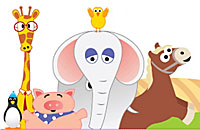 Leveractive has succeeded in creating two very engaging and very playful CD-ROM titles specifically for babies (and their parents). Two different titles, one called Shapes, the other My Animal Friends, allow babies to hit any key on a computer keyboard to bring up many fun animations, music and sound effects. The developers have made sure that there’s no way a baby can accidentally hit key combinations or the Escape key to cause havoc at the desktop level. Each title contains 14 charming activities. The content is very age appropriate and also offers English and Spanish set-up options right on the same CD.
Leveractive has succeeded in creating two very engaging and very playful CD-ROM titles specifically for babies (and their parents). Two different titles, one called Shapes, the other My Animal Friends, allow babies to hit any key on a computer keyboard to bring up many fun animations, music and sound effects. The developers have made sure that there’s no way a baby can accidentally hit key combinations or the Escape key to cause havoc at the desktop level. Each title contains 14 charming activities. The content is very age appropriate and also offers English and Spanish set-up options right on the same CD.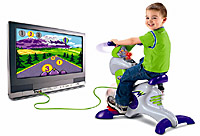 There was much buzz at Toy Fair with the announcement of this toy and rightly so. The Smart Cycle is a TV-based plug-and-play, cartridge-based platform that looks a like a cross between an exercycle for preschoolers and a
There was much buzz at Toy Fair with the announcement of this toy and rightly so. The Smart Cycle is a TV-based plug-and-play, cartridge-based platform that looks a like a cross between an exercycle for preschoolers and a 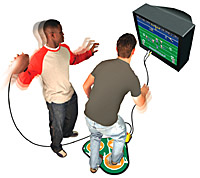 Here are two new plug-and-play products to come out of Radica, a cool tech toy company now owned by
Here are two new plug-and-play products to come out of Radica, a cool tech toy company now owned by 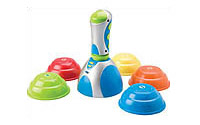 Hyper Dash is a technology toy that could be used indoors or out and does not require a television or computer to use. To start the game, 5 colored electronic targets are placed around the house or yard. Then, holding a talking electronic “tagger”, spoken instructions are given to the child, like find the blue target, then the red, etc. There are different game settings that focus on math skills, team work, and timed-based searches. As a child successfully finds the requested target, the music, pace, and complexity of each new request increases. This toy is recommended for children ages 5 – 8.
Hyper Dash is a technology toy that could be used indoors or out and does not require a television or computer to use. To start the game, 5 colored electronic targets are placed around the house or yard. Then, holding a talking electronic “tagger”, spoken instructions are given to the child, like find the blue target, then the red, etc. There are different game settings that focus on math skills, team work, and timed-based searches. As a child successfully finds the requested target, the music, pace, and complexity of each new request increases. This toy is recommended for children ages 5 – 8.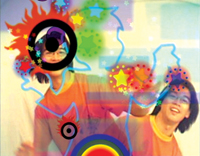 The company TikTokTech was showing two different stand alone TV plug-and-play devices. A small camera unit is placed on top of your television to play either music games or a combination of music and art games, depending on which device you purchase. While motion-based products have really only been around for a short while, these are the only titles available that provide a freeform artistic or musical experience for kids. For those that follow motion-based games, I strongly recommend checking out the
The company TikTokTech was showing two different stand alone TV plug-and-play devices. A small camera unit is placed on top of your television to play either music games or a combination of music and art games, depending on which device you purchase. While motion-based products have really only been around for a short while, these are the only titles available that provide a freeform artistic or musical experience for kids. For those that follow motion-based games, I strongly recommend checking out the  The ClickStart plug-and-play toy provides young children the experience computing in a fun and safe way, without tieing-up mom or dad’s home computer. This product includes a child-friendly keyboard and mouse, which can be set up to accommodate left or right handed users. The on-screen learning is guided by a friendly puppy named Scout. Children collect food treats for Scout as they complete games using numbers, letters, shapes and colors. This toy is a cartridge-based platform which means you can expect to see a number of different titles available to use with the base unit later this year. ClickStart is intended for children ages 3 – 6.
The ClickStart plug-and-play toy provides young children the experience computing in a fun and safe way, without tieing-up mom or dad’s home computer. This product includes a child-friendly keyboard and mouse, which can be set up to accommodate left or right handed users. The on-screen learning is guided by a friendly puppy named Scout. Children collect food treats for Scout as they complete games using numbers, letters, shapes and colors. This toy is a cartridge-based platform which means you can expect to see a number of different titles available to use with the base unit later this year. ClickStart is intended for children ages 3 – 6. The Easy Link Internet Launchpad acts like a mom-approved dashboard to preschool-safe content on the web. Say a child would like to visit their favorite Sesame Street online game. All a child needs to do is pick up one of the many miniature figurines, in this case Elmo ( or Barney, Clifford, the Wiggles, Thomas the Train, Bob the Builder, and others) and place the figurine in its designated spot… a little like placing the round peg in the correct hole. Once inserted, the device automatically will link its user to the games section of sesamestreet.com. No typing is necessary and all content locations are child-safe with no external links to undesirable content. This product works best with children ages 3 – 6.
The Easy Link Internet Launchpad acts like a mom-approved dashboard to preschool-safe content on the web. Say a child would like to visit their favorite Sesame Street online game. All a child needs to do is pick up one of the many miniature figurines, in this case Elmo ( or Barney, Clifford, the Wiggles, Thomas the Train, Bob the Builder, and others) and place the figurine in its designated spot… a little like placing the round peg in the correct hole. Once inserted, the device automatically will link its user to the games section of sesamestreet.com. No typing is necessary and all content locations are child-safe with no external links to undesirable content. This product works best with children ages 3 – 6.


 NetJet is a clever USB connected handheld device created by Tiger Electronics, a division of Hasbro. NetJet consists of a handheld game controller and a game key. Each game key inserted into the controller allows its user to access different casual game content online. Popular games using familiar characters and brands are available through this device, but not to those without the controller and keys. The NetJet environment is also free of advertising. No banner of pop-up ads here. Kids are also kicked offline once the NetJet device is removed from the USB port. By this coming fall season, 40 different casual game titles will be available for purchase. This product will appeal to casual gamers, both young and old, but Tiger is best know for their success with the tween market. This is not a learning product, but NetJet is an excellent use of plug-and-play technology.
NetJet is a clever USB connected handheld device created by Tiger Electronics, a division of Hasbro. NetJet consists of a handheld game controller and a game key. Each game key inserted into the controller allows its user to access different casual game content online. Popular games using familiar characters and brands are available through this device, but not to those without the controller and keys. The NetJet environment is also free of advertising. No banner of pop-up ads here. Kids are also kicked offline once the NetJet device is removed from the USB port. By this coming fall season, 40 different casual game titles will be available for purchase. This product will appeal to casual gamers, both young and old, but Tiger is best know for their success with the tween market. This is not a learning product, but NetJet is an excellent use of plug-and-play technology. This TV plug-and-play device first appeared at last year’s Toy Fair. It has a built in camera which allows it’s user to take a picture of oneself, then, through the controls on the tablet, modify hairstyles, add jewelry, and apply makeup. (Note: This product has brought about much discussion in our office about female stereo-typing and the kinds of messages it sends out to young girls. In our own testing of the product, we find that kids enjoyed the product greatly when we referred to it as a “stuffed animal makeover” toy. Kids couldn’t stop laughing when they gave a giant stuffed Pikachu and other fuzzy friends a new hairdo and pearls!) What’s new here is Radica has hinted it will be releasing an newer version of the device later this year but no formal announcement has been made.
This TV plug-and-play device first appeared at last year’s Toy Fair. It has a built in camera which allows it’s user to take a picture of oneself, then, through the controls on the tablet, modify hairstyles, add jewelry, and apply makeup. (Note: This product has brought about much discussion in our office about female stereo-typing and the kinds of messages it sends out to young girls. In our own testing of the product, we find that kids enjoyed the product greatly when we referred to it as a “stuffed animal makeover” toy. Kids couldn’t stop laughing when they gave a giant stuffed Pikachu and other fuzzy friends a new hairdo and pearls!) What’s new here is Radica has hinted it will be releasing an newer version of the device later this year but no formal announcement has been made.